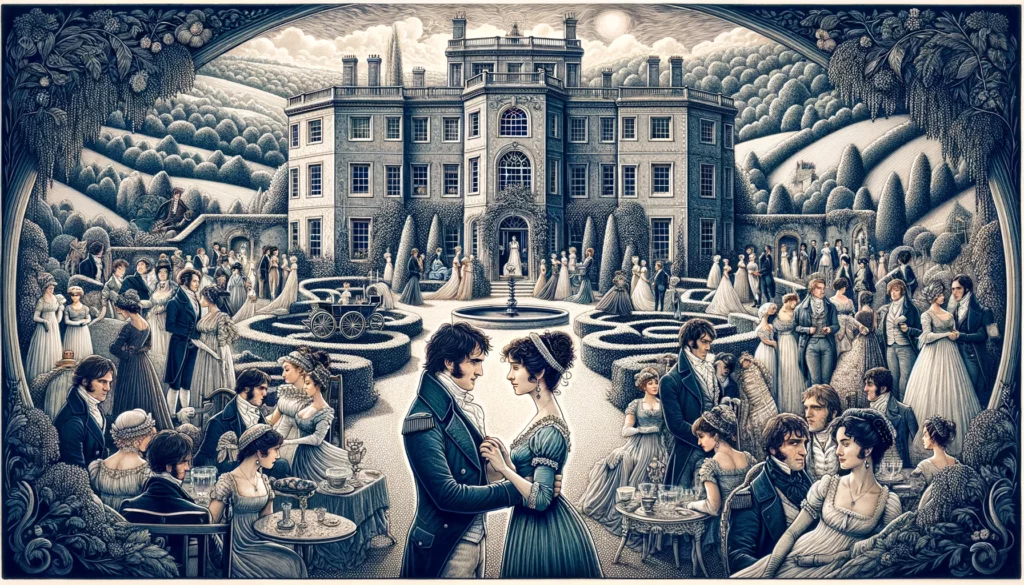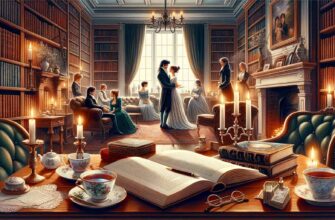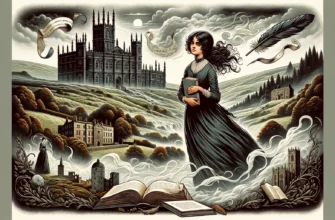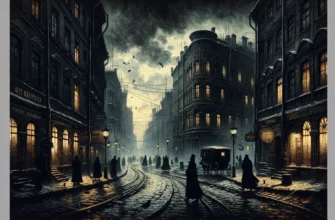The Setting and Historical Context of Pride and Prejudice
Jane Austen’s Pride and Prejudice, published in 1813, is firmly rooted in the social and historical context of late 18th- and early 19th-century England. The novel reflects the nuances of the Regency Era, marked by its distinct class hierarchies and gender roles.
During this period, societal norms were rigidly enforced, and women’s roles were primarily confined to domestic spheres and securing advantageous marriages. Austen, born in 1775 in Steventon, Hampshire, was well-acquainted with these societal norms, and her keen observations of rural life and social structures profoundly influenced her writing.
Political unrest and economic challenges, including the aftermath of the American Revolutionary War and the ongoing Napoleonic Wars, also characterized the era. Despite these turmoils, it was a time of cultural richness and literary flourishing. Austen’s novels, including Pride and Prejudice, offer a window into the lives of the landed gentry and the middle class, exploring their daily interactions and the societal pressures they faced.
Austen’s narrative is deeply embedded in the setting of the English countryside, with its estates, balls, and assemblies serving as the backdrop for the unfolding drama. The detailed depiction of settings like Bennet’s Longbourn, Bingley’s Netherfield, and Darcy’s Pemberley provides readers with a vivid portrayal of the physical and social environments that shape the characters’ lives and decisions.
This attention to setting and context is crucial in understanding the complex social dynamics and the intricate dance of manners and etiquette that define the novel.
Character Analysis and Development in Pride and Prejudice
The heart of Pride and Prejudice lies in its richly drawn characters, particularly the protagonists, Elizabeth Bennet and Mr. Fitzwilliam Darcy. Elizabeth, known for her wit and independent spirit, challenges the traditional expectations of women in her era.
Her keen observations and critical mindset set her apart from her peers, making her one of literature’s most beloved heroines. Her character arc, from her initial prejudice against Darcy to her eventual recognition of her misjudgments and growing affection for him, is a central theme of the novel.
Mr. Darcy, initially perceived as proud and aloof, undergoes significant character development. His transformation is revealed through his interactions with Elizabeth and the gradual unveiling of his true character—his integrity, generosity, and deep affection for Elizabeth.
The evolution of Darcy’s character, from pride to humility and love, mirrors Elizabeth’s journey and highlights Austen’s skill in crafting complex, multi-dimensional characters.
The novel also features a diverse cast of secondary characters, each contributing to the narrative and themes of the story in significant ways. Characters like Jane Bennet, with her gentle nature and steadfastness, Mr. Bingley, with his amiable disposition, and the more comic characters like Mrs. Bennet and Mr. Collins, provide a rich tapestry of human behavior and societal archetypes.
These characters enhance the story and emphasize the novel’s exploration of themes such as marriage, class, and individuality.
Themes of Marriage, Class, and Society
Marriage is a central theme in Pride and Prejudice, serving as a crucial element in the plot and reflecting societal norms of the time. The novel opens with the famous line, “It is a truth universally acknowledged, that a single man in possession of a good fortune, must be in want of a wife,” setting the stage for the exploration of marriage as a social contract and a means of economic and social stability.
The various courtships and unions in the novel, from Elizabeth and Darcy’s evolving relationship to Jane and Bingley’s more straightforward romance and even Charlotte Lucas’s pragmatic marriage to Mr. Collins, illustrate different aspects and motivations behind marriage during the era.
Class and social hierarchy also play pivotal roles in the novel. The distinctions between the landed gentry, the professional middle class, and the aristocracy dictate the characters’ interactions and prospects. The novel critiques the rigid class structures, as seen in the characters’ preoccupations with wealth, family connections, and social standing.
Elizabeth’s initial rejection of Darcy’s proposal, partly due to his pride and her prejudice against his social superiority, underscores the tension between individual desires and societal expectations.
The portrayal of society in Pride and Prejudice is nuanced and critical. Austen uses her characters and their interactions to expose the hypocrisies and the often superficial nature of social conventions.
Austen offers insights into the complexities of human behavior and the social fabric of her time through her sharp dialogue and the inner thoughts of characters like Elizabeth and Darcy. The novel’s enduring appeal lies in its incisive critique of societal norms and its celebration of the individuals who challenge and transcend those norms.
Note: Pride and Prejudice remains one of the most recommended classic novels, beloved for its timeless exploration of love, society, and the human condition.
Literary Techniques and Narrative Style
Jane Austen’s narrative style in Pride and Prejudice is distinguished by wit, irony, and free indirect discourse. This technique allows the third-person narrator to adopt the tone and voice of a character. This narrative style provides insights into the characters’ thoughts and feelings without direct dialogue, offering a deeper understanding of their inner lives and motivations.
Austen’s use of irony, particularly in her portrayal of societal norms and the institution of marriage, is a subtle critique of the limitations and expectations placed on individuals, especially women, during the Regency Era.
The dialogue in Pride and Prejudice is another element of Austen’s literary craftsmanship. The conversations between characters advance the plot, develop the characters, and explore thematic themes.
The witty exchanges, particularly between Elizabeth and Darcy, reveal their intelligence, values, and evolving perceptions of each other. Austen’s skillful use of dialogue enhances the realism of her characters, making their interactions and the societal settings they navigate feel authentic and relatable.
The novel’s structure, focusing on various families and social gatherings, allows Austen to weave a complex social tapestry. She presents a microcosm of Regency society through balls, dinners, and visits, showcasing the intricate social rituals and the significance of reputation and manners.
The attention to detail in the setting and social customs, the depth of character development, and the use of narrative techniques make Pride and Prejudice a compelling and critically acclaimed novel.
Reception and Critical Analysis through the Ages
Since its publication in 1813, Pride and Prejudice has garnered many responses from readers and critics alike. Initial reviews praised the novel for its wit and realism, although some criticized it for lacking romantic grandeur.
However, as the 19th century progressed, Austen’s work gained recognition for its depth and social commentary. Pride and Prejudice was celebrated for portraying Elizabeth Bennet as an intelligent and independent heroine.
Critical analysis of Pride and Prejudice in the 20th and 21st centuries has explored various themes, including gender roles, class, and marriage. Feminist readings have highlighted the novel’s critique of the limited options available to women and its celebration of Elizabeth’s assertiveness and moral autonomy.
Historical analyses have examined the novel in the context of Regency society, discussing how the characters navigate and sometimes challenge the strict social hierarchies of the time.
The enduring popularity of Pride and Prejudice is also reflected in its numerous adaptations and reinterpretations. From stage productions and film adaptations to modern retellings in various forms of media, the novel’s influence is evident in its persistent presence in popular culture.
Each adaptation brings a new perspective to the story, highlighting different themes or modernizing the narrative for contemporary audiences. Yet, the core of Austen’s work—its incisive social critique and compelling character dynamics—remains at the heart of these reinterpretations.
Pride and Prejudice in Popular Culture
Pride and Prejudice has transcended its original literary form to become a cultural phenomenon, inspiring many film, television, literature, and other media adaptations.
The 1995 BBC television series, starring Colin Firth and Jennifer Ehle, is particularly notable for its faithful adaptation of the novel and its contribution to the story’s enduring popularity. The series captured the essence of Austen’s narrative, emphasizing character development and the subtleties of social interaction.
The 2005 film adaptation, directed by Joe Wright and starring Keira Knightley and Matthew Macfadyen, offered a more cinematic interpretation of the novel. This version emphasized the story’s romantic elements and the English countryside’s visual beauty, attracting a new generation of fans and sparking renewed interest in Austen’s work.
In addition to these adaptations, Pride and Prejudice has inspired numerous retellings and variations, ranging from modern-day adaptations to works that explore the story from the perspective of secondary characters.
These reinterpretations showcase the novel’s flexibility and the universal appeal of its themes, proving that Austen’s exploration of love, class, and societal expectations remains relevant and resonant in various cultural contexts.
The Legacy of Pride and Prejudice and Its Relevance Today
Pride and Prejudice’s legacy is evident in its status as one of the most cherished and studied works in English literature. The novel’s exploration of themes such as love, class, and societal expectations continues to resonate with readers, reflecting the universal nature of Austen’s observations and the depth of her characters.
Elizabeth and Darcy’s journey from misunderstanding and prejudice to mutual respect and love remains a compelling narrative, celebrated for its insight into human behavior and social norms.
The relevance of Pride and Prejudice today can be seen in the ongoing discussions and analyses it inspires. The novel’s critique of social structures and its emphasis on personal integrity and moral growth offer valuable perspectives on contemporary issues.
Austen’s portrayal of Elizabeth Bennet as a strong, intelligent woman navigating her society’s challenges encourages readers to reflect on the progress and ongoing struggles related to gender equality and individual autonomy.
In conclusion, Pride and Prejudice is a testament to Jane Austen’s literary genius and keen understanding of human nature and social dynamics. The novel’s rich narrative, complex characters, and incisive social commentary make it a timeless classic, continually engaging new generations of readers and inspiring diverse interpretations and discussions.
Pride and Prejudice’s legacy is not just in its historical significance but its enduring ability to speak to the human experience, making it a cherished work in the canon of English literature.








